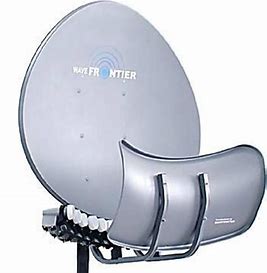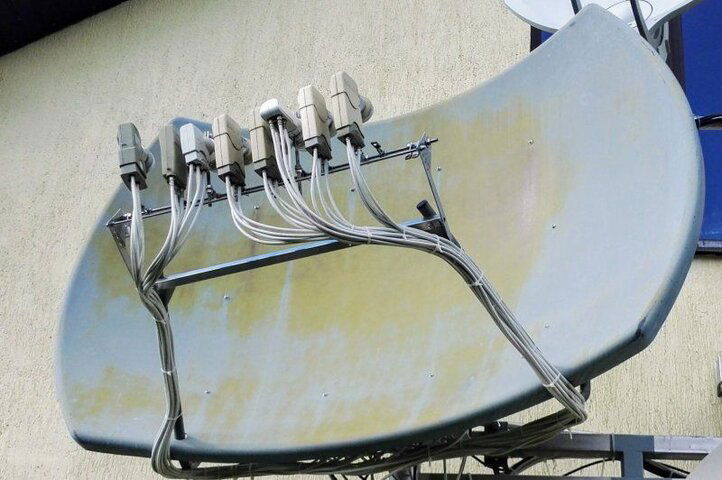Has anyone in here had any experience with one of these dishes? I saw them listed on a couple websites and was wondering if they can be used to pick up multiple Ku birds here in the USA. I assume they are adjustable for satellite locations just about anywhere. Here's a picture of one. It would be a good project to play with if you have a Dr.HD 1000S meter. I wouldn't attempt it without one.

T90 - 90CM Multi-Feed Toroidal Ku Dish Antenna
- Thread starter wvman
- Start date
- Latest activity Latest activity:
- Replies 14
- Views 6K
You are using an out of date browser. It may not display this or other websites correctly.
You should upgrade or use an alternative browser.
You should upgrade or use an alternative browser.
- Status
- Please reply by conversation.
Those are more aggravation than anything in NA. Our satellites are not as strong as ones in Europe and other places.
See this thread for more info: torodiol -t90
See this thread for more info: torodiol -t90
Those are more aggravation than anything in NA. Our satellites are not as strong as ones in Europe and other places.
See this thread for more info: torodiol -t90
Well, it's a nice concept, but not too practical over here. Looked like a nice alternative to the standard Ku setup.
When they started the project in 2001, they also had plans to build 120cm antenna...... but that never happened. So, 90cm double-reflector Gregorian antenna (Wavefrontier 90) is the biggest one.
A bigger dish would have been nice. At least it could have made up for the lack of power on the NA satellites. I'd be happy if at least one of the dish manufacturers we dealt with were still around. Hunting BUDs around here is getting slim unless you want fiberglass dishes. There's a ton of them sitting around all over the place. I'm trying to get a 12 foot Prodelin right now, but I don't think the guy's going to let it go.
He says he's going to paint a sign on it for his campgrounds. I doubt it will ever happen. I know the guy and he's about as energetic as a 3 toed sloth.
Yes, unfortunately there are no bigger double-reflector multi-focus than T90. But big toroidal multi-focus dishes are available.
There is old article from which history of T55 and T90 started.
Wavefrontier's New Multi-Satellite Antenna Outperforms Competition and Design Expectations in Independent U.S. Tests. - Free Online Library
There is old article from which history of T55 and T90 started.
Wavefrontier's New Multi-Satellite Antenna Outperforms Competition and Design Expectations in Independent U.S. Tests. - Free Online Library
Based on my experience with the T-90 model performance on NA satellites, I will assert that the linked product performance testing report as pure marketing PR BS. Unless Wavefrontier had extremely low expectations for the the T-55 design for the North America testing, it would be difficult to state with a straight face that the T-55 outperformed design expectations.... LOL!!! 

Based on my experience with the T-90 model performance on NA satellites, I will assert that the linked product performance testing report as pure marketing PR BS. Unless Wavefrontier had extremely low expectations for the the T-55 design for the North America testing, it would be difficult to state with a straight face that the T-55 outperformed design expectations.... LOL!!!
They probably didn't state how high their sights were set while testing the dish. I guess if you aim low enough, it's possible exceed your expectations every time.
I have three T90s and used them all for about 8 years to cover the entire North American arc. For most people they appear to be a little tricky to setup, but I had no problems at all. In fact I found it trivial when adding additional LNBFs. The LNBF holders are designed for 4 degree spacing, but by doubling up LNBFs with grounding clamps, I was able to achieve 2 degree spacing. There were a number of threads/posts here in the past on the T90s, by others and me, that provide more details. Performance wise, both RimaNTSS and I measured better than 90 cm results on-axis, falling to about 90 cm-level +/- 10 degrees off axis. By 20 degrees off-axis, the performance is about the same as a 76 cm dish. I generally stuck to the center 20 degrees and found the sensitivity to be reasonable for Ku in North America. Compared to multisatellite reception on parabolic dishes, the T90s are consistent and reliable units.
If they made a 1.2 m toroid, I would be happier, but my T90s made much more sense than having a gaggle of dishes, one per bird. I suffer from very high winds, which makes motorized 1.2 m dishes impractical, and even fixed 0.9 and 1.2 m dishes flop around too much when the wind starts chugging. One storm even ripped apart a C-band HTH motor on which I mounted only a 1.2m offset. The T90s could care less about wind, and held lock even in the worst storms.
Recently I retired two of my T90s because I switched to two 2.6 m Birdviews for part of my Ku coverage. I needed extreme performance for a few cases where neither 1.2 nor 1.8 m offsets were enough. I still kept one of the T90s and it is working as well as ever.
If they made a 1.2 m toroid, I would be happier, but my T90s made much more sense than having a gaggle of dishes, one per bird. I suffer from very high winds, which makes motorized 1.2 m dishes impractical, and even fixed 0.9 and 1.2 m dishes flop around too much when the wind starts chugging. One storm even ripped apart a C-band HTH motor on which I mounted only a 1.2m offset. The T90s could care less about wind, and held lock even in the worst storms.
Recently I retired two of my T90s because I switched to two 2.6 m Birdviews for part of my Ku coverage. I needed extreme performance for a few cases where neither 1.2 nor 1.8 m offsets were enough. I still kept one of the T90s and it is working as well as ever.
I had my T90 for ~13 years. Actually, it was may first antenna. But some time ago I've betrayed it in favor of another toroidal antenna, which is equivalent of 1m but not double-reflector. It is old dish and, unfortunately, not in production anymore. 
From time to time I make T90 upgrade kits for other hobbyists

From time to time I make T90 upgrade kits for other hobbyists

I had my T90 for ~13 years. Actually, it was may first antenna. But some time ago I've betrayed it in favor of another toroidal antenna, which is equivalent of 1m but not double-reflector. It is old dish and, unfortunately, not in production anymore. View attachment 131280
From time to time I make T90 upgrade kits for other hobbyists View attachment 131281
Believe it or not, I still have a T90 collecting dust on the back side of my garage. Would you still happen to have an upgrade kit laying around? This thread has actually peaked my interest in trying to breath life into that beast again!
I had my T90 for ~13 years. Actually, it was may first antenna. But some time ago I've betrayed it in favor of another toroidal antenna, which is equivalent of 1m but not double-reflector. It is old dish and, unfortunately, not in production anymore. View attachment 131280
From time to time I make T90 upgrade kits for other hobbyists View attachment 131281
Where do you get those clamp parts from? I've been looking for some for my experiments with such a dish.
I buy them in the local shop. I also looked elsewhere in internet-shops but did not find.Where do you get those clamp parts from?
- Status
- Please reply by conversation.
Similar threads
- Replies
- 34
- Views
- 2K
- Replies
- 14
- Views
- 856
- Replies
- 21
- Views
- 1K
- Replies
- 9
- Views
- 1K

